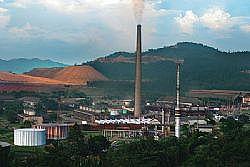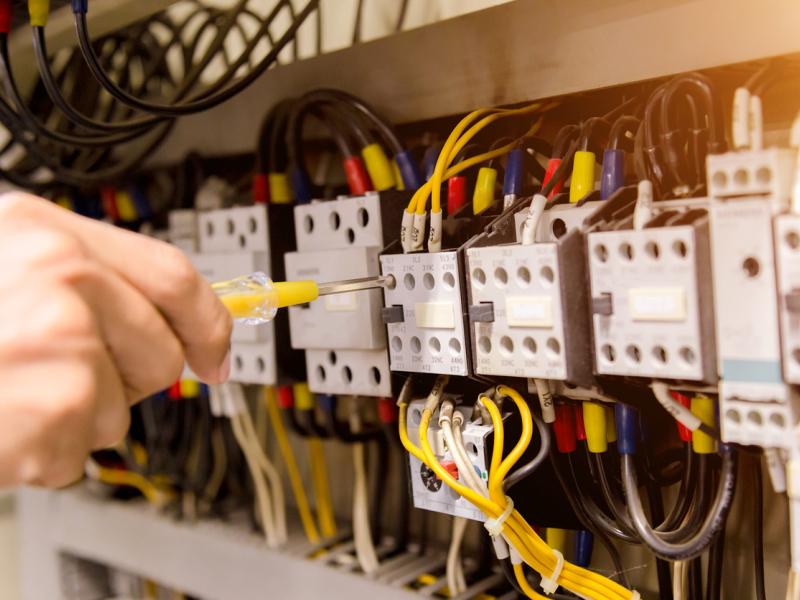FOR 34 years, the Falcondo nickel mine in the Dominican Republic produced upwards of 28,450 tonnes per year of nickel and ferronickel. Located about 50 miles north of the capital Santo Domingo, the mine site includes a metallurgical treatment plant, a crude oil processor and a 198 MW thermal power plant that supplies the mine’s electrical needs. The mine’s thermal power plant consists of three oil-fired steam generators and three 66 MW steam turbines that generate power for the plant and provide excess power to the Dominican power grid. Each year, all three turbines have to be shut down in turn from 14 to 21 days while they are inspected and maintained. In the past, one boiler and one turbine were taken offline one at a time, while the remaining boilers and turbines supplied the mine at reduced capacity. "Historically, we simply reduced ferronickel production during the thermal plant maintenance," says Wanda Rosario, Falcondo’s senior buyer in charge of special projects. "But, the worldwide demand for ferronickel has become very strong. We decided it would be better to keep the mine working at full capacity by bringing in temporary rental power during the maintenance period." Working with Argico, the local distributor for Cummins Power Generation and Cummins Power Rent, the mine rented 32 trailerized diesel generators for three months during the thermal plant maintenance. According to Luis Gigante, president of Argico, 27 of the generators operated online continuously at their 1.6 MW continuous rating, while five of the generators were used for peaking power and maintenance backups. Each rental generator is composed of a Cummins Power Generation PowerCommand DQKC diesel generator set and its own control system and fuel supply. Each generating unit is standby-rated at 2 MW and continuous-rated at 1.6 MW. Their individual digital master control systems assure high reliability, precise synchronization with the power grid and the other generators and maximum fuel economy. Cummins provides power "We provided the 64 MW temporary power plant to the mine as a turnkey project," says Gigante. "We handled delivery of all the generating units, provided installation, commissioning, maintenance, repair and complete system operation. We even devised a system to reduce the time spent on oil changes from three hours to just 45 minutes – not unlike a Formula One pit crew." Cummins was able to complete the project in only 45 days. Twenty-seven of the 32 rental generators operated continuously over the three-month maintenance period that included turbine inspections and replacement of some tube-wall panels in the boilers. Rosario says that each steam turbine needs to go through a major overhaul once every six years. Because such an overhaul can take upwards of 80 days to complete, one turbine undergoes a major overhaul every two years to spread the impact on power production. Power reliability an issue While the mine is connected to the national power grid, Rosario says that the grid has not been stable enough for their mining operation. "In order for us to operate 24/7, we’ve had to find our own sources of energy. About 70 percent of the electricity generated is used in our electric furnaces. The next largest portion operates machinery such as mills and driers. The rest is service power, for compressors, motors and lighting and such." Fuel for the thermal power plant boilers, the ore reduction process, mining equipment and the rental diesel generators is all refined onsite. Crude oil is piped from Santo Domingo to the mine’s "topping plant" which converts the oil into naphtha, diesel and fuel oil. The electrical power for the crude oil pumping station is provided by two permanently installed diesel generating units from Cummins Power Generation that together produce 3.75 MW. About 35 percent of the refined petroleum product is naphtha and that is used in the mine’s reduction furnaces that process the ore. Under ordinary circumstances, the amount of diesel fuel produced by this plant is rather small, only 10 percent. "During the time we rented the diesel generators, we purchased a different kind of crude oil mix that allowed us to produce more diesel fuel for the generators," says Rosario. Power for a multi-step process Falcondo is only one of seven mines in the area that supply refined ore to mills and smelting facilities. At Falcondo’s open-pit operation, overburden is carefully removed to expose the ore. Hydraulic backhoes remove the ore from a seam that averages over 20 feet thick, and mined-out areas are contoured and reforested with fast-growing trees. The first stage of metallurgical processing involves the high-temperature conversion of nickel and iron oxides to a metallic state in what are known as "shaft furnaces." The ore is then compressed into briquettes and smelted in the electric furnaces that get their power from the thermal power plant. After refining, the metal is cast into ferrocones, which contain about 38 percent nickel and 62 percent iron. If the worldwide demand for ferronickel remains high, Falcondo will continue to bring in replacement power during its thermal power plant maintenance period. The mine’s proven ore reserves should last another 15 years, and with the continuing increases in the popularity of stainless steel products, demand should stay high for the foreseeable future. For more information go to www.cumminspowerrent.com.
Mine maintains full production during boiler maintenance
General
Monday, 13 February 2006






